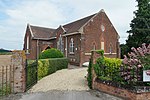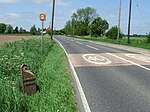Quadring Fen
Hamlets in LincolnshireLincolnshire geography stubsSouth Holland, LincolnshireUse British English from January 2014

Quadring Fen is a hamlet in the South Holland district of Lincolnshire, England. It is situated 2 miles (3.2 km) south from the A52 road, 5 miles (8.0 km) east of Billingborough and about 7 miles (11 km) north-west from Spalding. The village of Quadring is 2.5 miles (4.0 km) to the east. The smaller settlement of Quadring High Fen is 0.5 miles (0.8 km) to the south. Quadring Fen forms part of the Lincolnshire Fens which was an area of low-lying land prone to flooding prior to drainage works being carried out between 1635 and 1638.
Excerpt from the Wikipedia article Quadring Fen (License: CC BY-SA 3.0, Authors, Images).Quadring Fen
Beck Bank, South Holland Quadring CP
Geographical coordinates (GPS) Address Nearby Places Show on map
Geographical coordinates (GPS)
| Latitude | Longitude |
|---|---|
| N 52.876122 ° | E -0.23852 ° |
Address
Beck Bank
Beck Bank
PE11 4LE South Holland, Quadring CP
England, United Kingdom
Open on Google Maps










